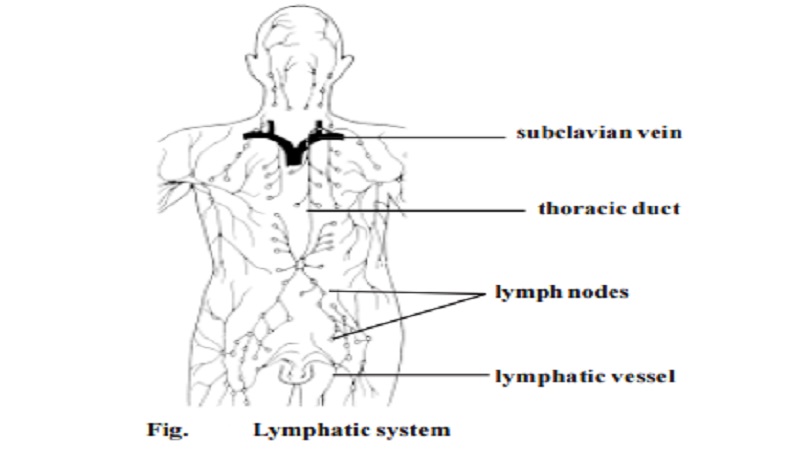Chapter: BIOLOGY (ZOOLOGY) Standard XI first year 11th text book Assignment topics question and answer Explanation Definition
Human Lymphatic system - Lymphoid cells and tissues, Thymus, Lymph nodes, Spleen, Tonsils, The lymphatic circulation

Human Lymphatic system -
Human Lymphatic system
Lymphatic circulation along with blood circulation plays a key role in maintaining the fluidity in all regions of the body. It helps to maintain fluid balance in tissues and it absorbs fat from the digestive tract. It also functions as body's defence system against micro organisms and other harmful substances. This system includes lymph, lymphocytes, lymphatic vessels, lymph nodules, lymph nodes, tonsils, the spleen and the thymus gland.
Lymphoid cells and tissues - Lymphatic organs contain lymphatic tissues. These tissues primarily consist of lymphocytes. They also contain macroph-ages, dendritic cells and reticular cells. Lymphocytes are a type of white blood cells. They originate from red bone marrow and are carried by blood to lymphatic organs and other tissues. There are several classes of lympho-cytes. The B-lymphocytes or B cells synthesize antibodies for recognizing and neutralising alien macromolecules. T- lymphocytes can recognize and se-lectively kill cells infected with viruses. B and T lymphocytes are produced from stem cells present in the bone marrow. The T lymphocytes get matured only after entering into Thymus, a lymphoid organ through circula-tion. Maturation and differentiation of B cells will occur in the bone marrow itself. Thus the thymus and bone marrow are described as central or primary lymphoid organs.
Thymus - It is a roughly triangular, bilobed gland. It is located in the mediasti-num (ie., between the lungs). It lies between the sternum and the pericardium. Its size varies with age. It is largest in the early part of life (upto 15 years). At birth it weighs 10 - 15 g. After puberty it greatly decreases in size.
Each thymus lobe is surrounded by a thin capsule made of the connec-tive tissue. It has 2 layers. The inner layer is the medulla, the outer layer iscortex. The lymphocytes are found only in cortex layer.
Lymph nodes - These are small round structures. Their size ranges from 1-25 mm. They are distributed throughout the course of the lymphatic vessels. These nodes are found all over the body. However they are concentrated as aggregations in 3 regions of the body. These are the inguinal nodes in the groin, the axillary nodes in the axillary region and the cervical nodes of the neck.
The lymph enters the lymph nodes through afferent lymphatic vessels and exits through efferent vessels. The nodes contain open spaces called si-nuses. The sinuses are lined with phagocytic cells.
Spleen - It is roughly the size of a clenched fist. It is located on the left side of the abdominal cavity. It has a fibrous capsule. The spleen contains two types of lymphatic tissues, namely the red pulp and the white pulp.
Tonsils - These are the largest lymph nodules. They provide protection against bacteria and other harmful materials. In adults the tonsils decrease in size and may disappear. There are 3 groups of tonsils in the pharyngeal walls. Of the three, the palatine tonsils are usually refered to as 'the tonsils'. These are larger lymphoid masses on each side of the junction between the oral cavity and the pharynx. The pharyngeal tonsil or adenoid are found near the junc-tion between the nasal cavity and the pharynx. The lingual tonsil is a loosely associated collection of lymph nodules on the posterior surface of the tongue.
The lymphatic circulation - The lymph fluid from the tissues is drained by lymphatic capillaries. These capillaries though present in many tissues are absent in epidermis, hairs, nails, cornea, cartilages, CNS and bone 123 marrow. The lymphatic capillaries join into larger vessels. The larger vessels pass to local or remote lymph nodes. These vessels and associated lymph nodes are arranged in regional groups. Each group has its region of drainage. Nodes within a group are interconnected. Such regional groups with nodes and vessels are organised in (1) Head and neck (2) Upper limbs (3) Lower limbs (4) Abdomen and pelvis (5) thorax.
The regional vessels return to the venous blood circulation via the right and left lympho venous portals. Nearly eight lymphatic trunks con-vergeat the site of the vertebral column and open into the venous portals nearer to the neck.
Related Topics